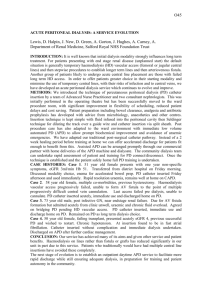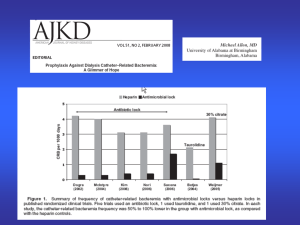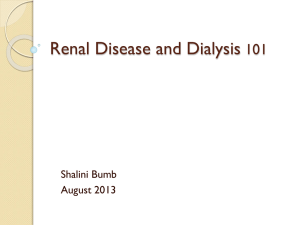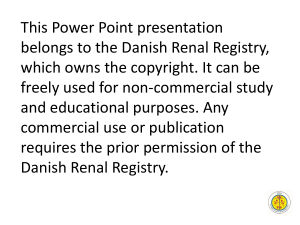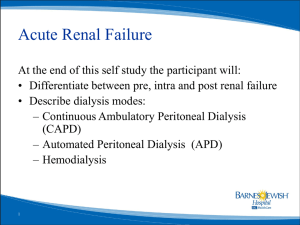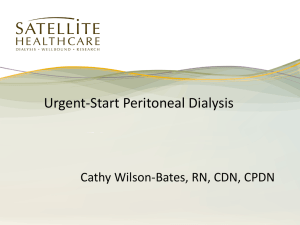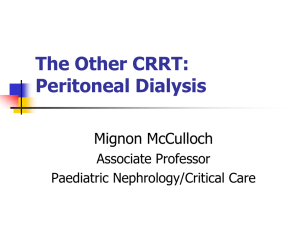Options for Dialysis Access
advertisement
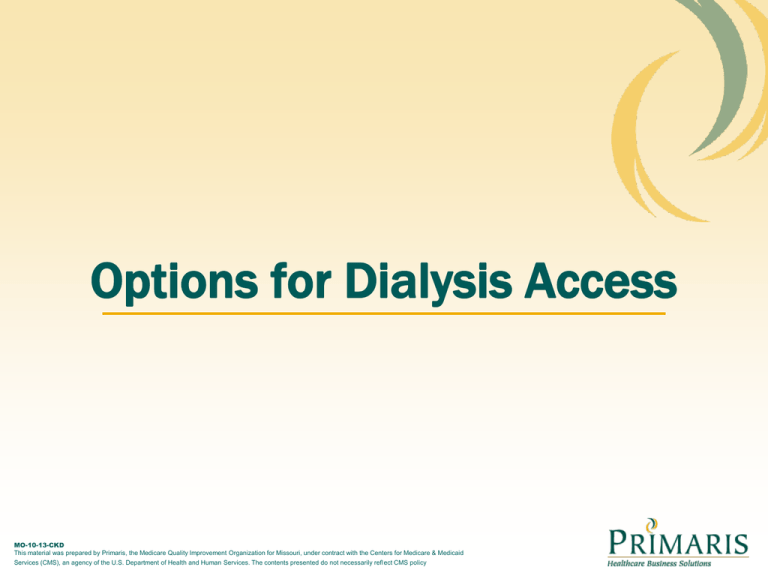
Options for Dialysis Access MO-10-13-CKD This material was prepared by Primaris, the Medicare Quality Improvement Organization for Missouri, under contract with the Centers for Medicare & Medicaid Services (CMS), an agency of the U.S. Department of Health and Human Services. The contents presented do not necessarily reflect CMS policy Why dialysis access? When your kidneys fail, dialysis is often required if transplantation cannot be done. Dialysis replaces kidney and access is crucial for those whose kidneys have failed. Dialysis Options There are two form of dialysis. One type of dialysis is performed using the abdominal cavity (peritoneal dialysis) Another type is performed by filtering the blood (hemodialysis) Peritoneal Dialysis Access Peritoneal dialysis requires access to the peritoneal cavity. During a minor outpatient surgery, a small soft tube is put into the abdomen called a PD catheter. Peritoneal Dialysis Catheter One end of the catheter rests in the peritoneal cavity, while the other extends from the body. It takes a few weeks to heal. The PD catheter stays in place throughout your time on PD. Peritoneal Dialysis Catheter National Kidney and Urologic Diseases Information Clearinghouse http://kidney.niddk.nih.gov Hemodialysis Hemodialysis circulates blood through a machine outside of your body to remove toxins and excess fluid. The machine then pumps the cleansed blood back into your body. Hemodialysis Access Dialysis access refers to the creation of an entranceway into the bloodstream so that the blood can be cleansed by the dialysis procedure. Hemodialysis Access This entrance way is commonly located in the arm, the leg, or the neck. The best type of dialysis access is provided by a fistula Types of Hemodialysis Access Fistula (arteriovenous fistula) Graft (arteriovenous graft) Catheter Preparation for Access Ideally before you start dialysis a access should be in placed and ready to use Fistula should be placed 6 months prior to starting dialysis Graft should be placed 3-6 weeks prior to starting dialysis Preparation for Access Before an access is placed, you will need to see a surgeon for evaluation. The surgeon will do certain procedures before deciding what access is right for you. Preparation for Access These procedures are – Noninvasive vein mapping with an ultrasound to help determine which veins can be used – Blood lab tests What is a fistula or AVF? Is created by directly connecting an artery and a vein This causes the vein to grow larger and stronger for easy access Fistulas can be place in forearm or upper arm Fistula or AVF It is done as minor outpatient surgery Usually take 6 to 12 weeks to develop Considered the best long-term vascular access because it provides adequate blood flow, lasts a long time, and has a lower complication rate than other types of access. AVF Diagram Pros of AVFs The gold standard Lasts longer than other access types, usually 20 plus years Fewer infections than grafts and catheters Increased blood flow means more effective dialysis treatment Cons of AVFs Visible as a bulge under the skin Takes longer to develop for use Not always possible for all patients Graft If your veins are small or weak then graft is a better option for dialysis access. A graft connects an artery to a vein using a soft artificial tube implanted under your skin. AVGraft Grafts can be placed in your arm or leg but most are placed in the forearm Can be used after 3-6 weeks of placement AVGraft Diagram Pros of Graft Implanted during minor outpatient surgery Can be used within 3-4 weeks Cons of Graft Usually only lasts 3-5 years More likely to get infected than AVF More likely to have blood clots than an AVF Longer bleeding time than an AVF after dialysis needles are removed Catheter If your kidney disease has progressed quickly, you may not have time to get a permanent vascular access before you start hemodialysis treatments. You may need to use a venous catheter as a temporary access. Catheter A catheter is a tube inserted into a vein in your neck, chest, or leg. It has two chambers to allow a two-way flow of blood near the groin. Pros of Catheter Dialysis can be performed immediately after placement Easy to remove and replace Cons of Catheter Highest infection rate Direct line to the heart contributes to more serious life threatening infections Clots more frequently Difficult to obtain sufficient blood flow to allow for effective removal of waste materials through dialysis Bathing and swimming are not recommended due to infection risks Not a permanent access option Take Home Messages There are many factors that go into deciding which type of vascular access is best for you. Be a well-informed and knowledgeable patient who has all the facts. Take Home Messages Continued… Educating yourself is the first step toward being in control of your dialysis and healthcare. Choosing a fistula is your best choice.
